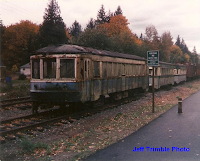Jeff Trimble, a traction fan from California, recently visited the museum and took a tour of the 205. It wasn't the first time he'd seen the car, though - he helped move it back in 1989! At the time it was one of three cars owned by Bob Hively (the other two were Brill Master Units from Yakima, WA) and stored in Snoqualmie, Washington at the Northwest Railway Museum. NRM needed more space and asked that the cars be removed, so Hively had them transported down to Yakima to the trolley operation there, which at the time was using a Portuguese streetcar and a couple of non-revenue pieces original to the operation. The Master Units were moved on Army trucks while the 205 was transported on a truck belonging to Paul Class. Only a couple of years later Bob Hively passed away. After his death all three cars were acquired by the group in Yakima, with the 205 quickly being put up for sale. The rest, as they say, is history.
Jeff was kind enough to send us some photos of the move. Thanks!

The 205 - at the time painted in an approximation of the livery it wore on Portland Traction, where it was numbered 4003 - sits in Snoqualmie with the two Yakima Master Units behind it. The car was in rough shape at the time, having spent three decades sitting unprotected in a rain forest area.

The car is eased onto a ramp for loading onto a truck. This part of the car is currently the southwest corner and has been cosmetically restored.

Some of the people involved in moving the cars, with the 205 in the background loaded atop a Gales Creek Enterprises (Paul Class) truck with the Master Units beyond.



Interesting photos. Didn't Hivey also own the third ex-Yakima Master Unit that's still "in the woods?"
ReplyDeleteDavid
The one photograph that shows a closeup of the car makes it appear to have been literally buried in a mudslide at one point.
ReplyDeleteThis is not meant as a criticism, but it is astonishing that something as simple as a tarp or the like, could have prevented a great deal of the resulting damage from it being exposed to the elements. Why one was not applied is beyond me.
Bruce, here is my experience with tarps. You need to get a really good DURABLE tarp. The car body must be prepared to eliminate any projections and cover any corners. You need to tie it down like your life depended on it. The tarp might cost $1500 to $2000 and last for 2-5 years, with regular checkup and repairs to make sure it is secure.
ReplyDeleteThat is a lot of money and hours to buy a relatively short period of protection. There is no simple answer, but any preservation group is limited in available funds, and if something is being let go, that would not be the first thing I would spend my money on.
One operation in particular has devised a system of plywood and rubber membrane cocooning that is relatively long lasting. Higher initial cost than a tarp, but if you are going to mothball something for the future, a viable option if you have the money.
Bob Kutella
Bob's post implies that tarping is not worth the cost, but I would disagree. It depends quite a bit on the quality of tarp you buy, prep done to the car, and the work you put into keeping it tight. We have one car out in Yard 14 that was tarped in 1996 and, while admittedly it has spent about 5-6 of the intervening 15 years indoors, its tarp is still in pretty decent shape. Recently IRM has started to use tie-down straps to hold tarps solidly in place and this seems to help a lot with preventing the tarp from moving around and ripping on protrusions.
ReplyDeleteSnoqualmie is just about the worst place in the world for a Railroad Museum, it's downwind from a waterfall, everything grows moss, when I was there in the 1980's there was a Vancouver? car with a foot of moss on the waterfall side.
ReplyDelete-Hudson
Folks,
ReplyDeletei do not think Mr Hiverley was paying any attention to his cars late in his life. A lot of collectors have grand ideas and then after a number of years a dose of reality couses them to move on to other things.
Happily a number of the late running cars from Portland have been preserved at museums.
We have two of them at the Western Railway Museum. The sister car to #205 is going to be restored as the next big project.
It is going go come back to Portland 40XX and be run on our ling line. It was one of the first two cars to arrive at Rio Vista Junction in 1960.
Ted Miles
For my friend Frank Hicks - I did not say that tarps could not be made to work. The Sand Springs 68 spent several years tarped when it sat in the old YARD ONE. It required constant attention, made it difficult to get into and out of the car on a regular basis. As temporary shelter, a tarp can provide relief, if done right - but is still just temporary. The list of tarped cars at IRM that have had the coverings fail is almost legendary in length, some in as little as one year's time.
ReplyDeleteBob Kutella
Hello, I am looking for information on the third Master Unit, and Pacific Northwest Traction No. 60, the observation car from the Spokane & Inland Empire. If anybody knows what happened to them, and possibly the other cars, then please post here. I am a traction fan from the Seattle metro area, and I've been investigating these cars for nearly two years. Thank you. - Nikolaus Bautista
ReplyDelete